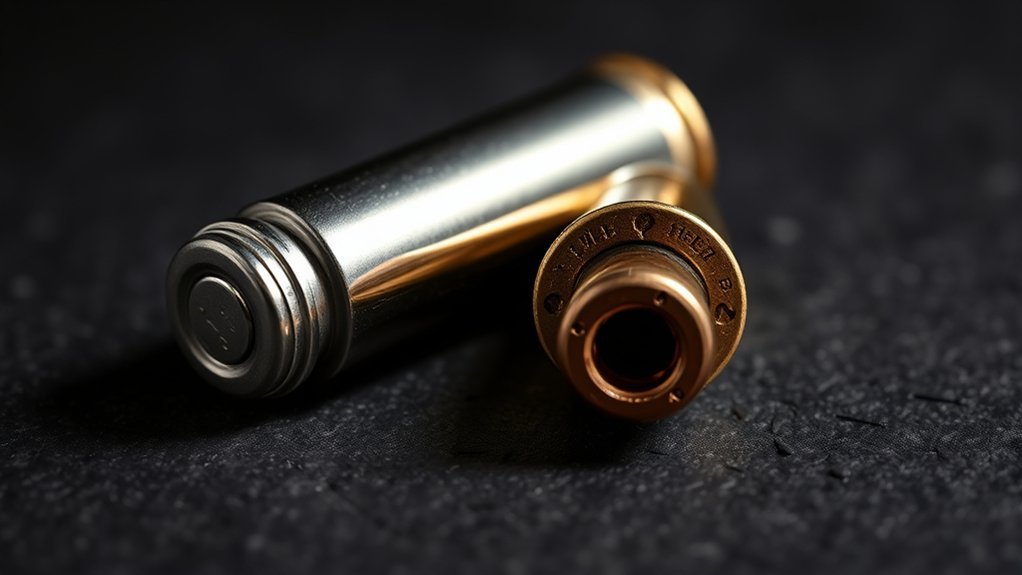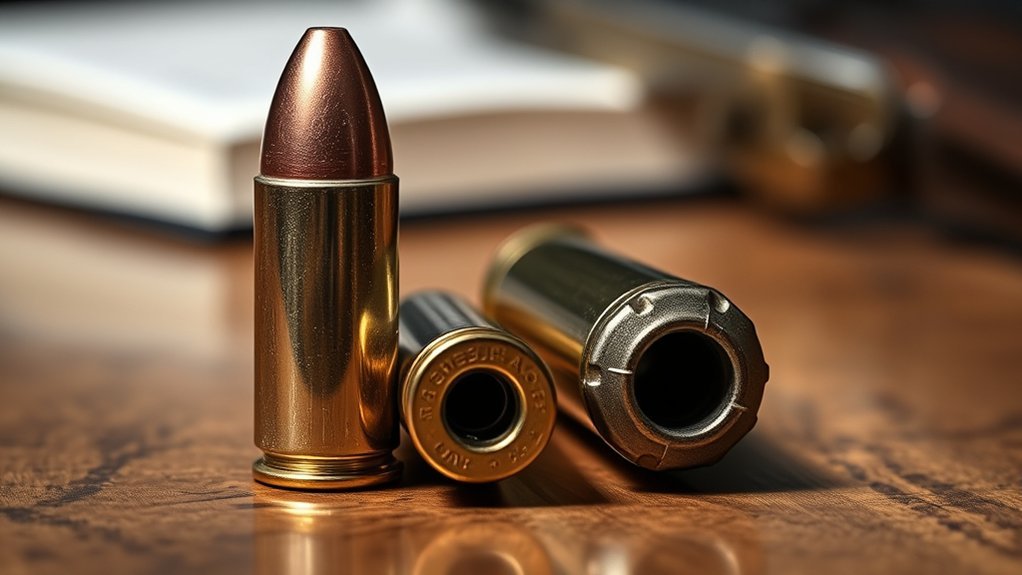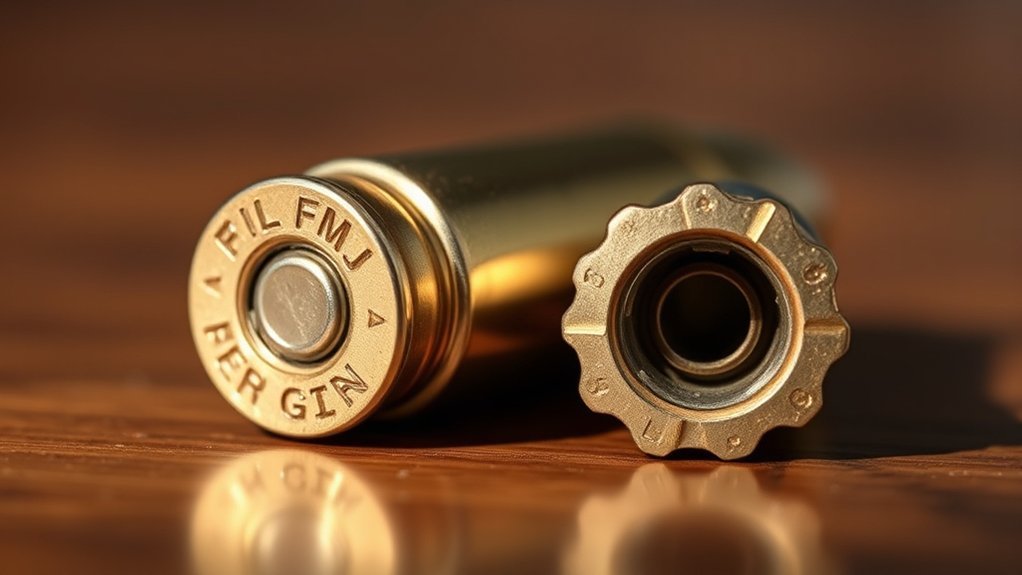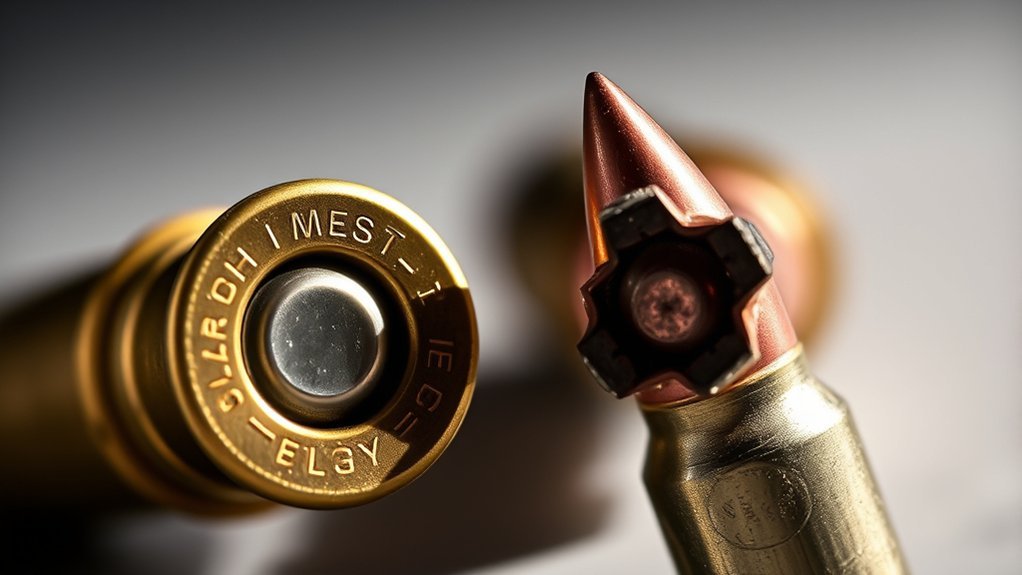There’s a common belief that all ammunition types serve the same purpose, but that’s not entirely true. Understanding the differences between Full Metal Jacket (FMJ) and Hollow Point (HP) ammunition is essential for both performance and legal compliance. Each type has its strengths and weaknesses, impacting your decision on which to use. What factors should you consider when choosing between them? Let’s explore the nuances that could influence your choice considerably.
Understanding Full Metal Jacket (FMJ) Ammunition

When you consider ammunition types, it’s important to understand what Full Metal Jacket (FMJ) rounds are and how they function. FMJ ammunition features a soft lead core encased in a harder metal shell, usually copper. This design promotes reliable feeding and reduces barrel fouling, making FMJ a popular choice for training and target shooting. The solid construction guarantees that the bullet maintains its shape upon impact, allowing for deep penetration without expansion. However, FMJs may not transfer energy as effectively as other types, leading to less stopping power. Regarding legality, FMJ rounds are generally permissible for civilian use, but it’s necessary to check local regulations. Understanding these characteristics will help you make informed decisions based on your shooting needs.
Understanding Hollow Point (HP) Ammunition

Hollow Point (HP) ammunition stands in contrast to Full Metal Jacket (FMJ) rounds, primarily due to its design and intended use. HP bullets expand upon impact, creating a larger wound channel. This design makes them particularly effective for self-defense and hunting scenarios. Here are some key characteristics of HP ammunition:
- Expansion: Designed to expand on impact, increasing stopping power.
- Wound Channel: Creates a larger wound channel than FMJ rounds.
- Penetration: Typically penetrates less deeply, reducing the risk of over-penetration.
- Weight Retention: Often retains more weight after impact, enhancing effectiveness.
- Legal Considerations: Use may be restricted in certain jurisdictions due to their lethality.
Understanding these aspects helps you make informed decisions about your ammunition choices.
Performance Differences: FMJ vs. HP

When comparing FMJ and HP ammunition, you’ll notice significant differences in penetration and expansion characteristics. FMJ rounds typically penetrate deeper but lack the expansion that HP rounds provide upon impact. Understanding these performance aspects is essential for evaluating terminal ballistics and making informed choices for specific shooting scenarios.
Penetration and Expansion
While both FMJ (Full Metal Jacket) and HP (Hollow Point) ammunition serve distinct purposes, their performance regarding penetration and expansion reveals significant differences that are essential for choosing the right round for specific situations.
- FMJ typically penetrates deeper, making it suitable for shooting through barriers.
- HP expands upon impact, increasing stopping power by creating a larger wound channel.
- FMJ may over-penetrate, posing risks to bystanders in self-defense scenarios.
- HP’s design limits penetration, reducing the risk of collateral damage.
- Your choice should consider target type, whether it’s for defense or target shooting.
Understanding these differences will help you select the right ammunition based on your specific needs and circumstances.
Terminal Ballistics Impact
Understanding terminal ballistics is essential for evaluating the performance differences between FMJ and HP ammunition. FMJ rounds typically penetrate deeply, making them effective for target shooting and military applications. However, they may over-penetrate in self-defense scenarios, posing a risk to bystanders. In contrast, HP rounds are designed to expand upon impact, creating a larger wound channel. This expansion reduces the likelihood of over-penetration, increasing effectiveness in stopping threats quickly. You’ll find that the energy transfer in HP rounds leads to more significant tissue damage, which is vital in defensive situations. Ultimately, your choice between FMJ and HP should align with your specific needs, whether it’s target practice or personal protection. Understanding these differences can enhance your decision-making process.
Penetration and Expansion Characteristics
Although both full metal jacket (FMJ) and hollow point (HP) bullets are designed for specific purposes, their penetration and expansion characteristics differ markedly. Understanding these differences is essential for making informed decisions on ammunition selection.
FMJ and HP bullets serve distinct purposes, with key differences in penetration and expansion that influence ammunition choice.
- FMJ Bullets: Penetrate deeply, ideal for target shooting.
- HP Bullets: Expand upon impact, causing greater tissue damage.
- FMJ’s Design: Maintains structural integrity, reducing deformation.
- HP’s Design: Creates a larger wound channel, enhancing stopping power.
- Impact Dynamics: FMJ may over-penetrate, while HP minimizes risk to bystanders.
In essence, if you prioritize deep penetration, FMJ rounds excel. Conversely, for maximum expansion and effective stopping, HP bullets are your best choice. Your decision should align with your specific shooting needs and context.
Ideal Uses for FMJ Rounds
FMJ rounds are often the go-to choice for target shooting applications due to their reliable accuracy and consistency. They’re also ideal for training and practice, allowing you to hone your skills without breaking the bank. Additionally, their cost-effective nature makes them a practical option for regular shooters looking to maximize their practice sessions.
Target Shooting Applications
When looking for ammunition that excels in target shooting, you’ll find full metal jacket (FMJ) rounds to be an excellent choice due to their design and performance characteristics. FMJ rounds are ideal for a variety of reasons:
- Cost-effective: They are generally cheaper than other types of ammunition.
- Feed reliably: Their smooth profile guarantees better feeding in semi-automatic and automatic firearms.
- Reduced lead exposure: Since they minimize lead exposure, they’re safer for indoor ranges.
- Minimal deformation: Their design prevents excessive deformation, guaranteeing consistent performance.
- Versatile: FMJ rounds are suitable for various shooting disciplines, from precision to recreational shooting.
These attributes make FMJ rounds a preferred option for honing your skills in a target shooting environment.
Training and Practice
While honing your shooting skills, utilizing FMJ rounds for training and practice offers distinct advantages. FMJs are designed for consistent performance, allowing you to focus on mastering your technique without worrying about expansion or deformation. They provide reliable cycling in semi-automatic firearms, ensuring you become familiar with your weapon’s operation.
Here’s a quick comparison highlighting the ideal uses for FMJ rounds:
| Aspect | FMJ Rounds |
|---|---|
| Penetration | High |
| Recoil | Low |
| Accuracy | Consistent |
| Cost | Generally lower |
| Training Value | Excellent for practice |
Cost-Effective Ammunition
Choosing FMJ rounds for various shooting applications makes sense not only for training but also for cost-effectiveness. Their lower price point compared to hollow points allows you to maximize your practice time without breaking the bank. Here are some ideal uses for FMJ rounds:
- Training: Perfect for honing marksmanship skills at the range.
- Competition: Commonly used in matches where precision is key.
- Plinking: Great for informal shooting sessions and fun practice.
- Defensive Situations: Can be beneficial for target identification before engaging.
- Long-Distance Shooting: Often preferred for consistent performance at range.
In each of these scenarios, FMJ rounds deliver reliable performance while keeping costs manageable, making them a smart choice for many shooters.
Ideal Uses for Hollow Point Rounds
Hollow point rounds are primarily designed for self-defense and law enforcement applications, as their unique design maximizes stopping power while minimizing the risk of over-penetration. When you’re considering ammunition for personal protection, hollow points are ideal because they expand upon impact, creating a larger wound channel. This expansion decreases the likelihood of passing through an assailant and injuring innocent bystanders.
Additionally, hollow points are effective in home defense situations, where you want to neutralize a threat quickly without risking collateral damage. Their performance makes them suitable for law enforcement, as officers often need reliable stopping power in high-stress encounters. Ultimately, choosing hollow points enhances your ability to protect yourself while prioritizing safety in your environment.
Legal Considerations for FMJ Ammunition
When considering ammunition options, it’s important to understand the legal implications surrounding FMJ (full metal jacket) rounds. These implications can vary considerably based on your jurisdiction and intended use. Here are some key legal considerations to keep in mind:
- Regulations: Different states may have specific laws governing the use of FMJ ammunition.
- Self-defense: FMJ might not be viewed favorably in self-defense cases compared to hollow points.
- Usage: Some shooting ranges restrict or prohibit FMJ for safety and environmental reasons.
- Military restrictions: Certain military installations may have limitations on civilian use of FMJ.
- Insurance and liability: Using FMJ in a shooting incident could affect liability and insurance claims.
Always stay informed about local laws to guarantee compliance and safety.
Legal Considerations for Hollow Point Ammunition
Understanding the legal landscape surrounding hollow point ammunition is vital for responsible gun owners. Many jurisdictions permit the use of hollow points, recognizing their effectiveness for self-defense. However, laws vary considerably by state and municipality. Some areas impose restrictions or outright bans on hollow point ammunition, often citing concerns about excessive lethality. Furthermore, using hollow points in self-defense cases can influence legal outcomes, as courts may scrutinize your choice to determine intent. It’s important to familiarize yourself with local laws and regulations to guarantee compliance. Additionally, documenting your training and the circumstances surrounding your firearm usage can bolster your defense in legal proceedings. Always stay informed; what’s permissible in one place may not be in another.
Making an Informed Decision: FMJ vs. HP
How do you choose between full metal jacket (FMJ) and hollow point (HP) ammunition for your specific needs? Understanding the differences is essential for making an informed decision. Consider these factors:
Choosing between FMJ and HP ammunition is crucial; consider your purpose, penetration needs, cost, recoil, and legal regulations.
- Purpose: FMJ is ideal for target practice, while HP is designed for self-defense.
- Penetration: FMJ penetrates deeper; HP expands upon impact, reducing the risk of over-penetration.
- Cost: FMJ is generally more affordable than HP.
- Recoil: FMJ often has less recoil, making it easier to control.
- Legal Issues: Be aware of local regulations regarding the use of HP ammunition.
Conclusion
In the battle of FMJ versus HP ammunition, understanding their distinct characteristics is essential for making informed choices. While FMJ offers deep penetration for precision shooting, HP rounds deliver greater stopping power with their expansion capabilities. Remember, choosing the right ammo isn’t just about performance; it’s also about adhering to legal standards. So, arm yourself with knowledge and make your selection wisely—it could be the difference between a miss and a bullseye in critical situations.

